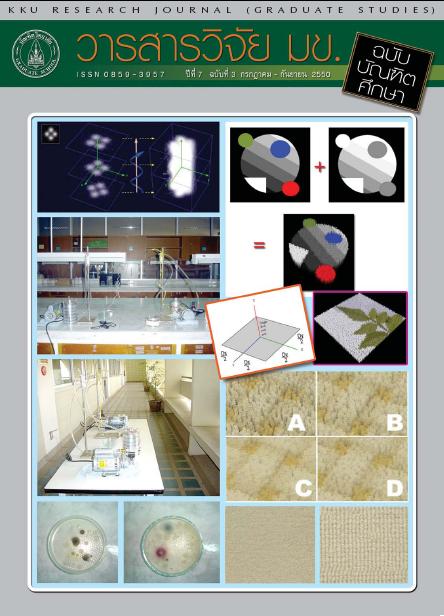Health Problems of Working and Health Care of Silk Weaving Groups Amphoe Ban Kaow at Chaiyaphum Province(ปัญหาสุขภาพจากการทำงานและการดูแลสุขภาพจากกลุ่มอาชีพทอผ้าไหมอำเภอบ้านเขว้า จังหวัดชัยภูมิ)
Keywords:
Occupation health problem(ปัญหาสุขภาพตามหลักการ), Health care(การดูแลสุขภาพ), Silk weaving(กลุ่มอาชีพทอผ้าไหม)Abstract
เป็นการวิจัยเชิงสำรวจ เพื่อศึกษาปัญหาสุขภาพที่เกิดจากการทอผ้าไหม โดยทำการสัมภาษณ์ กลุ่มอาชีพทอผ้าไหม จำนวน 231 คน และทำการสังเกตการณ์ทำงานทอผ้าไหมและสำรวจสภาพแวดล้อมบริเวณที่ทอผ้าไหม ผลการวิจัยพบว่า กลุ่มอาชีพทอผ้าไหม เป็นเพศหญิง ร้อยละ 98.3 อายุเฉลี่ยเท่ากับ 47.6±11.7 ปี ประสบการณ์การทอผ้าไหมเฉลี่ยเท่ากับ 16.45 +10.9 ปี แสงสว่างบริเวณที่ทำงานทอผ้าไหมมีความพอเพียง ร้อยละ 92.6 การระบายอากาศบริเวณที่ทำงานทอผ้าไหมมีความเหมาะสม ร้อยละ 81.1 พบปัญหาการปวดเมื่อยกล้ามเนื้อมากที่สุดคือ บริเวณเอว, เข่า, ไหล่, ต้นขา และหลังส่วนบน ร้อยละ 50.6, 38.5, 35.1, 34.6 และ 27.3 ตามลำดับ การดูแลสุขภาพตนเองในสภาวะปกติของกลุ่มอาชีพทอผ้าไหม มีการรับประทานอาหารครบ 3 มื้อ ร้อยละ 89.6 ได้รับอาหารที่มีคุณค่าตามโภชนาการทั้ง 5 หมู่ และร้อยละ 87.0 รับประทานอาหารที่กากใยสูง ร้อยละ 74.5 ดื่มน้ำสะอาดประมาณ 6 -8 แก้วต่อวัน ร้อยละ 75.8 มีการพักผ่อนนอนหลับวันละ 6 – 8 ชั่วโมง ร้อยละ 90.5 มีการกลั้นปัสสาวะเมื่อปวดขณะทอผ้าไหม ร้อยละ 24.2 มีการดูแลสภาพแวดล้อมที่พักอาศัยให้สะอาดเรียบร้อยน่าอยู่ ร้อยละ 77.1 และยังขาดการออกกำลังกาย ร้อยละ 34.6 เมื่อทดสอบหาความสัมพันธ์ของปัจจัย พบว่า ลักษณะการก้มคอขณะทำงานเป็นประจำมีความสัมพันธ์กับการปวดเมื่อยกล้ามเนื้อบริเวณไหล่ซ้าย และไหล่ขวาอย่างมีนัยสำคัญทางสถิติ (p-value < 0.05) การเอี้ยวตัวขณะทำงานเป็นประจำ มีความสัมพันธ์กับการปวดเมื่อยกล้ามเนื้อบริเวณข้อศอกซ้าย และเอวอย่างมีนัยสำคัญทางสถิติ (p-value < 0.05) การบิดข้อมือขณะทำงานเป็นประจำ มีความสัมพันธ์กับการปวดเมื่อยกล้ามเนื้อบริเวณ ต้นขา เข่า และน่องอย่างมีนัยสำคัญทางสถิติ (p-value < 0.05) ดังนั้น ผู้ที่ทำงานควรมีอิริยาบถขณะทำงานที่ถูกต้องตามหลักการศาสตร์ และมีการปรับสภาพหน้างานและเครื่องมือที่ใช้ในการทอผ้าไหมให้เหมาะสมกับสรีระของแต่ละบุคคล และมีการบริหารร่างกาย รวมทั้งมีการปรับเปลี่ยนอิริยาบถขณะทำงานและหยุดพักเป็นระยะ เพื่อลดปัญหาการปวดเมื่อยกล้ามเนื้อและปัญหาสุขภาพอื่นจากการทำงาน A survey research was done with objectives to study health problems causing by silk weaving. The observation of work habits, the interview and the survey of working environment were employed to gather the data of 231 people by silk weaving profession. To analyze the data, the SPSS for Windows was used for the statistic values; number, percentage, average, standard deviation and Chi-square (χ2 -test). The results of the research found that 98.3 % were female. The average age was 47.6 years old (SD=47.6±11.7) with 16.45 years of work experience in average (SD=16.4±10.9). The light at work place was enough with 92.6 %. Air ventilation at work place was also appropriate with 81.1 %. Anyway, the most muscular fatigue found at waist, knee, shoulder, thigh and the upper part of back was 50.6, 38.5, 35.1, 34.6 and 27.3 %, respectively. Focusing on self-health care of a group of silk weaving profession in the normal condition, 89.6 % had enough three meals. 74.5 % of them obtained the nutritious values from five groups of essential food. 87.0 % drank 6-8 glasses a day in average. 75.8 % had high fiber food. 90.5 % slept for 6-8 hours daily. 24.2 % of them suppressed urination while weaving silk. 77.1 % tidied their living places. In addition, a lack of exercise was 34.6 %. The correlation test found that the usual posture of neck bending while working had a correlation to the muscular fatigue at the left and right shoulder with the statistic significance (p-value<0.05). Usual body bend during working had a correlation to the muscular fatigue at the left elbow and waist with the statistic significance (p-value<0.05). Hand twisting during working had correlation to the muscular pain at thigh, knee and calf (p-value<0.05). Therefore, the workers should have the appropriate attitude according to the principle of Ergonomics. Besides, working condition and silk-weaving instruments to be suitable for each workerûs physical features should be adjusted. To reduce the muscular pain while working, exercise, posture changing and break taking should be done.Downloads
Published
2014-11-20
Issue
Section
วิทยาศาสตร์สุขภาพ



